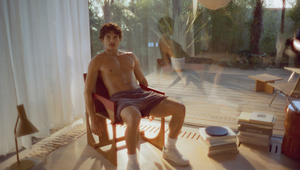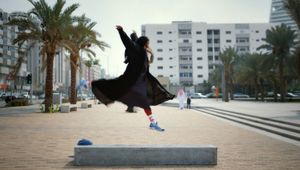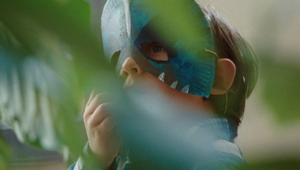
Danny Sangra: My Creative Process

Creativity can’t be reduced to an algorithm. There’s no right or wrong way to bring an idea to life, but without a system to channel them through, creatives’ best ideas might never see the light of day.
In an unprecedentedly wide-ranging interview, we’ve been given access to the creative process of one of the UK’s most distinctive and engaging directors; Lief’s Danny Sangra.
Danny’s work is perhaps best represented across three projects. Firstly the short film he created alongside Lief, ‘Parlour Games’. The short is an ode to the classic parlour film, and is shot against an (almost) entirely red backdrop. It’s also the result of a unique development process, with actor Margaret Clunie providing the voiceover the storyboard from her bathtub whilst sipping a gin & tonic. You can watch the film, which has been released exclusively for this article, here.
Secondly, his hilariously dry spots for Selfridges show off the director’s comedic side. Somehow the ads manage to be both stylish and funny, and were sparked off while Danny was cleaning his house.
Finally, a series of idents produced for the tradesmen recommendation website Checkatrade prove how important a good storyboard can be when it comes to establishing a unique tone.
To find out how the director brought each of these projects to life, as well as exploring his creative process more generally, LBB’s Adam Bennett spoke to the Lief director.
Danny’s Creative Process
LBB> What’s the first thing you do when you start working on a new project?
Danny> With my personal film projects, it usually starts with a scene. There’s always a piece of dialogue that sparks the rest of the film. A simple message or just one element I find interesting and then I start writing and everything begins to sort itself out.
With commercial work, when I get sent the initial brief, I have five mins of thinking “I can’t think of anything!” and then I end up writing pages and pages of ideas and notes. Nothing strict, just everything I’m thinking with no constraints. After that I start to organise my thoughts. After those initial five minutes I tend to think of ideas very quickly. It’s mostly a matter of working out the best way to communicate it.
LBB> Do you have a creative structure that you tend to follow or do you change the way you work from project to project?
Danny> I wouldn’t say I have a creative structure. There are structures that come with the creative process naturally but I don’t typically stick to anything personally. My projects always vary.
I make a lot of personal projects that I have to initiate. This isn’t the same with commercial work. When I’m working with an agency and client, there are structures in place to keep everyone moving together. As I have my background of being a designer/illustrator I tend to be very clear about how I envisage the film. I will start to mock up my own storyboards and ways to show what I want to do. I tend to go into a lot of detail and there are moments where it may seem a little OCD but I just really get into a project so I can’t help it. Also the more information I have, the easier it is when people start asking questions. Ultimately the structure is in place so when you are actually making the piece, everyone has understood how you got there.

Above: An except from Danny’s hand-drawn collection of storyboards
LBB> What is creativity?
Danny> Something bored people do.
LBB> So you’re a bored person?
Danny> 100% yes. I started out as an illustrator because I was sitting in my mum’s hair salon on a Saturday just doodling. It’s not like I had a phone or whatever to entertain myself with, so I just had to fill the time however I could. Otherwise I don’t think I could have kept myself entertained. I’m sure it doesn’t work like this for everyone but I need to be bored in order to spark that imagination. And then it’s a case of having that idea in the back of your head that you can’t get rid of. And the only way to shake it off is to act on it and create something.
LBB> Do you think it’s important to set limits on your creative work/vision at the start of a project?
Danny> I did until recently. It’s fine to start like that but at some point you need to take the brakes off.
LBB> What changed recently?
Danny> I think for a director, from the start of your career you have this sense in the back of your mind that you can’t just go right ahead and make a high speed chase, or a scene in outer space. So when I started out I was putting the focus on making the most out of what I had. But now I’m at a point where maybe I was holding back for too long - in fact maybe I even lost interest for a while in writing those kind of huge scenes because in my head I was subconsciously thinking, “well there’s no way I can get hold of two sports cars”.
But now I think I’m in a slightly better position than I have been before, and I can start writing these things that are a little bit bigger. But it’s only recently that this hit me. I don’t think you should ever set limits on your creativity, but I do think it’s important to be aware that you can’t just start out with ‘it happens in space’ or something like that.
LBB> Do you have a creative philosophy?
Danny> I don’t know if it’s a philosophy but I tend to not overly talk about what it is I want to make. I just do it. I constantly hear people discuss in length about how they are going to do something. I find it makes it harder because you keep creating obstacles for yourself. Or you wait for so long it’s become far bigger than you initially thought. Even if it doesn’t pay off, that’s not the point. It’s the body of work I look at.
Parlour Games
You can watch the full film right here
LBB> In what way did your creative process differ for this short film as opposed to the commercial work?
Danny> This was one of my most truly creative projects. I had this idea that I knew wasn’t commercial, it was a style of dialogue I had to get out of my system. I knew if I didn’t make the film the way I wanted to, it would be in the back of my head for years (this is often the case but this project was like the painting you want to make that on the surface looks nothing like the rest of your work but you need to create it to evolve).
On my personal projects, I have nobody to answer to, so I can let my characters do what they want. There’s no time limit either. The final piece comes down to how much I can play with the characters.
Lief and I split the costs and funded it ourselves. The fact that Lief backed me so much on this project is huge. Often production companies want you to make your own work, but only if it helps them sell you commercially. This film was as far from commercial as you could get. And then suddenly I said “I think it should be in a red room”. They knew I knew what I needed.
I’ve spent so long making films ranging from no budget to big budgets that I know when I need something and when I don’t. Lief knew that if I was asking for it, I needed it.
LBB> Can you tell us how you used Margaret Clunie’s amazing Toy Story-version of the film whilst filming yours?
Danny> The toy film happened when I was trying to describe the shots and the movement to my DP, Marcus Autelli. I had drawn storyboards but it wasn’t enough. I knew I wanted to shoot everything on dolly and track, and I wanted to cover wides, close ups, two shots etc. all in the same take. We wanted every shot for each scene to be different (only the wide is a repeated angle). I don’t like shooting coverage, I prefer to get the shot that I want. If I have to go to coverage shots, I know there’s been a mistake. Which is why I spent time on my storyboards and describing the camera movement in the most clear way.
The characters don’t move much in Parlour Games so the camera created the movement. I shot the film in two days so we didn’t have a long time to work the camera movement on set. I also had to minimise laying the track because I didn’t have the time to keep breaking.
Above: Danny’s original storyboards for the film
I knew Margaret knew the pacing of the dialogue. I called her to send me over a recording of her reading the entire script. She sent it back in a few hours (she recorded it while having a bath) I didn’t realise she would do all the voices too!
I ended up working out my shots playing the recording and shooting the entire film on a phone with my toys.
What’s crazy is that when I finished the final film, I placed the toy film next to it. They match up almost perfectly. Even Margaret’s narration matches the actors’.
Above: Margaret Clunie’s bathtub-retelling of Parlour Games
Vogue x Selfridges ‘Everything Looks Better In Eyewear’
LBB> Can you describe your creative process for this project?
Danny> I was already working with Vogue on another project when this came in. Selfridges asked if I’d make a film and just let me write whatever I wanted so long as it took place in the ‘Eyewear Hall’.
I wrote it in about 30 minutes. It was one of those where the idea comes straight away (clearly the time was right). ‘Everything Looks Better In Eyewear’ - I was doing my house up at the time some I was clearly influenced by all the mundane tasks I was doing.
After Lief sent the pitch over, I was waiting to get a response telling me what changes they wanted to make. However nothing came through and suddenly just said, “OK, see you at the shoot”.
I’ve worked on so many projects with Lief and there’s an understanding in place that helps enormously. It’s a trust thing. I know, they know how to sell in and translate my work, so I generally don’t have to worry about knowing every step that goes on without me. It’s a big part of it, having people around me that help get the best out of me.
LBB> Again, this seems like a perfectly cast spot - was this a case of finding the perfect person for the role or did the vision come together after you knew who would play the role?
Danny> I knew the character I wanted. She totally got it. I just said, “act bored and never smile”.
LBB> Did you consciously draw on any influences for this project?
Danny> Some of my biggest influences were [British comedy duo] Reeves and Mortimer. I think my humour developed watching them when I was in school so I’d say I just combined that with Vogue.

Above: Danny’s storyboards for the Selfridges project
Checkatrade ‘Check, Check, Check’
You can watch the idents here.
LBB> Can you describe your creative process for this project?
Danny> I was sent about 14 ideas for scenes to make eight idents. I started to work out the ones I thought would work, then I wrote a few of my own and did some rewriting on others so they all are off the same pen. Basically trying to make myself laugh within the parameters of the project.
I was given a lot of freedom. Fortunately the agency and I were clearly on the same page.
LBB> It’s amazing how closely the finished spots mirror the initial storyboards. How difficult is it to ensure the work keeps on that track whilst filming?
Danny> It’s not difficult at all. We had very little time (we shot all eight in one day) so you don’t have the luxury of testing things out. You need to know what you need to get. However, there’s always something that just doesn’t work and then you have to use the time you’ve saved on those more difficult moments.
Performances are different. I can set the frame, but the performance might not be working. Without rehearsals you have to work those things out on set. The fun part.
I think my boards drawn in my style get the humour across to most people, that’s why it’s important for me to do them myself!
LBB> The cast definitely seem to have bought into the humour - did that aspect turn out the way you always expected?
Danny> Yes, mostly. They almost all performed how I wanted them to perform. Once I get the casting confirmed, then I tweak things to fit them. Often you write things without knowing who the cast is. You have your dream cast, but you may not find them in the casting process. You may find someone better. Mostly I find people that I can work with, even if the casting wasn’t spot on, I spot something in the way they handled the direction. I like working with people who, even if they don’t get the humour on the page, they trust you enough to do as you say.
One thing I always stick to is that I never cast people who try to be funny. I always want my cast to play everything straight faced.
Above: Danny’s storyboards for the Checkatrade project















